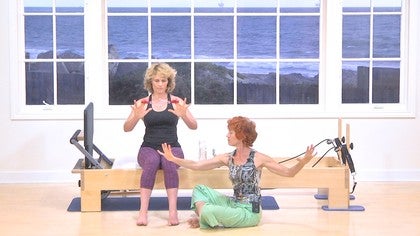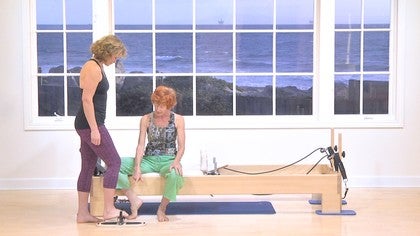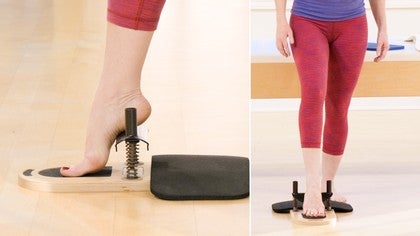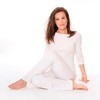Description
If you don't have a Foot Corrector, Amy shows how you can use a Small Tennis Ball to do the same exercises.
About This Video
Transcript
Read Full Transcript
Hi everyone. I'm here for foot class today. Uh, you can do this class stand alone. You can do it at the beginning of a reformer workout chair, Matt, anything before you go running or just maybe after a long day at work. Uh, traveling is be really good and you can do this while you're traveling, but I have the balanced Bonnie foot corrector. Grots also makes a foot corrector. If you don't have this at home, don't worry, get a ball. Often you can use a tennis ball and you can place the tennis ball in certain places. You can also use this, I'll explain that when it comes, but I think feet are incredibly important to, to work and we'll um, you'll feel all the way up from your foot to your hip ideally. And the other things you'll need for this class, it does the hand towel and that'll come later.
And then I also have a few different sizes of pads here. And the reason being, so here I am going to put my corrector down on the floor. What I want to show is if I put, as I put my heel on the, on the board or the heel on the ground, if you're at home and you go over your corrector and you can't quite get the, the metatarsal is up on top of the Dome, you may need a little lift to boost your heel up. So I'm going to use my black pad. Let me see what happens. That gives, Yep. And gives me just a little bit more opportunity to get my foot the metatarsal up on top of the plate. Okay. Standing is best if this is bothering anybody.
You can also just sit down and do, it's harder sitting really. You want some leverage and what I want you to first do is just set your heel back, your toes on top, and look at your own foot. And what do you see? Chances are you see an ankle that's rolled to the outside. That's what we want to look at. Uh, and, and to correct a little bit. So the arches of the feet, first of all are going, we want to lift them and give them a sense of pulling up and doming up into the space in the foot.
So I want to just could try to clutch the top of my plate, not by knuckling this way and shortening my toes, but by reaching the toes out long and then perhaps perhaps perhaps pressing the plate down. The the foot corrector that I'm using, the springs are quite heavy. They do make them with softer springs, but you know what the heck. If you've got the heavy springs, you're going to work a little harder. So if you're at home doing this on a tennis ball, your heels on the floor and you're going over your tennis ball or a racket ball or a lacrosse ball. Okay, so here we go. And you're trying to sustain a push down on the plate evenly, right to left and then release. Lengthen the toes, press down and lift.
Lengthen the toes, press. Let's just seeing this one. Keep looking down at your own foot and I want you to see if you can begin seeing the metatarsal here come to surface. What I mean is you're going to see some like white appearance of the Fascia, connective tissue. That means the bottom foot muscles are really lifted. You're activating that arch up. If it doesn't happen right away, that's okay too. That's what you're looking for and look as spread. I'm pretty happy with my foot right now. It's really spreading left to right.
We want that stretch of the foot. Okay, let's do a couple more. I'm trying to avoid bending my knee and rocking all my body weight forward. That's another way to do it, but for right now, just isolating the foot and ankle without deviating into pronation or super nation. Okay, one last time. Press down and concentrate on the back of your upper leg. You may even use your hand and put it back there and see if you can feel some muscle tone, which you should.
All the way from the back of your hip down through your leg to your foot. That's what we're after. Some of that hip to foot connection, long toes and then release. Okay. Part B. So we can call that part a cut. Feels so good. It feels light, like it's just gonna fly. I want you to take the arch of your foot right on top now and just kind of bounce the plate. Do this on your tennis ball. And a tennis ball is nice because it's bouncy.
There's a springiness that the springs have of course that we want to inform the bottom of the foot in a kind of a a trampoline, like quality, a little bouncing and also changes in rhythm so it changes your nervous system response a little. Okay, I'm trying not to do it from my knee, but more of the arch of my foot. Bounce, bounce, bounce, bounce, bounce, plenty part. See you step over it and place the ball of the foot on the front, black or on the floor. Place your heel up top or on the ball. And then same thing. This might give you a much better chance to look at alignment. Let me deviate here. Not quite right.
So I've got this little zigzag line of my femur to my ankle. We're looking for alignment here. So from hip, knee, Shin, second toe ish. Okay, you may want to put your hand on your thigh, the very end by your knee. I'm going to bend a slight bit. I'm going to take my other hand on my shinbone and kind of twist in opposite directions here. Just a little bit of rotation. And now try to push the plate down with your heel lift. Heel lift. I'm gonna stand up and see if I can do it.
Heel lift, keeping that alignment the best we can. Okay. Now, once again, I'm my hands going to go back by my hip. I want to feel strength from my hip to heal and push down. So the push becomes from here. Now lifting the plate, almost like you're bringing your heel up to your hip. Hip Pushes to heal. He'll pulls up to hip, push the hip to heal. It's a tongue twister. Heel to hip. Okay, so those springs are providing the strength, opportunity to resistance. So it's not just arbitrary pushing on. That's not really doing a lot.
You want the resistance and the ecentric work. Couple more push and lift, push and lift and then it's always nice to do a comparison. It's for me night and day that this, this whole side feels floaty and light and so I want to enjoy that on the other side. Heel long, toes up top. Try right away to spread from big toe joint across to Pinky wide long toes and push the plate down. And Lyft, this is my weaker side even after all these years, but you can hear more spring movement on this.
I don't know if you can pick that up, but I'm actually getting a little different kind of push than I was on the first side. Need to work my alignment. So again, as you're working a precision principle hip to knee, need a foot, let's hold it and see if you can find the hip to foot relationship. There should be a nice tautness from top to bottom. Control how you lift press. If you can look at your foot and see some white metatarsal heads coming to surface. They kind of do a little bit.
I need to think about bringing my arch up away from the floor slightly.
That's that vibration is kind of going all the way through your bones. Believe it or not. Some say it goes into the brain. I think it does in a good way. Okay. A place, a ball of the foot forward now or over your tennis ball. And here's the trick for me. This is where I want that leg to go. That's just where it likes to hang out.
So I want to crouch a little bit and to stabilize this hand to maybe realign and then look down at your heel and see if you see your heel [inaudible]. You got to get it right into parallel and organize it. So you want that. He'll ride behind your ankle and then try to push from the butt to the foot and lift the butt to the heel. You can see this as a little harder for me. Push. I'll stand up and try it. Hip To heal. Trying all I can do not to just launch onto my leg. That's something different.
Isolate, pushing down. Now let's add that slow lift of the plate. Lift, lift, lift, push and lift. With control and push. I need to practice my left foot and up. And once again, push and lift. Okay, and then again your comparison. Standing side by side actually feels fairly even now.
So let's move on and we'll do, I'm going to move my corrector out of the way. Move your ball out of the way and just stand again two feet but advanced one foot forward, relatively parallel legs. And I've got my ball of foot on the floor, toes long and what I'd like to do is just spring off and push the floor down and peel the toes up. So it's a lot about the metatarsal is now the mid foot to toes, midfoot to toes without hiking the HIPPA. So let's just say rural center down at the very low distal part of our body.
You'll start to feel your calf muscles coming alive. I think this hip probably getting some work. Let's speed it up. Think of your feet like hands, whatever your hands can do. We want our feet to be able to do. Maybe again, I'm not counting, I'm going to wear, I feel like I probably couldn't do too many more, which is about now and stand man. Other side. Spread the toes. You're on the ball of the foot. Hip, two foot and peel in a spring. Those toes off.
This is also good for balance work. Quiet landing, quiet, take off. Hips are level. It really focused. Distal work, distal meaning the farthest away from your center and let's pick up the pace. Push, push, whoa. Push off. Push off, push, push without betting the knee. I'm going to count down eight, seven. My calf is really alive right here. Four, three, two, one. You see me do that kind of thing on the jump board too.
It's really good for the jump board preparation. Okay, let's move down. I'm going to sit on the, go ahead and sit on the floor and next one are like, we're going to focus a little more dexterity of the big toes and then the toes themselves and kind of these piano roll movements. Okay. We don't need the pad. All right. Look down at your feet. We're in parallel. I'm just leaning forward over my legs slightly and I'm holding onto my shins. You could hold knees, you could go underneath.
What I want you to look at and feel is parallel. Okay. And lift. If you can just your big toes, the other four toes, press down as you hitchhike your, your big toes up and then put them down.
There's some tautness that's happening up in the ankles themselves. This is great for those of us who've got really playful ankles, wobbly ankles. Do you want to top and release and Taut? Strengthening. Okay, one more now. Piano roll. I'm going to start at my pinkie and try to do pinky toe. Fourth Toe, third, second. First all 10 up pinky fourth, third, second. Big Toe. Isolating each one three more times.
Thinki four, three, two, one. This is so good for the feet. Lift. Pinky fourth, third, second. First one more. Lift and pinky fourth and all the way. And my feet are burning. There's a lot of muscle work going on in here.
Okay, next one is picking up sand. So if we were outside on our beach, what I want you to visualize, there's yet you're pulling, you're gripping your toes in picking a big chunks of sand and letting it go. So again, like I said, what are your hands can do? What can your feet can your feet do it and try to use this, the arch, the foot, there's that foot corrector, there's that tennis ball. You're right over the top of it.
Lift and lift and lift and lift. Five more lift. And again, repetitions. You could do as many as you feel you want to do. Great thing to do. Watching TV. Okay, so that picking up sand, we're going to adding to the towel. All right, so the towel, lay it out flat. I'll do one foot at a time. We'll start with my right.
What you wanna do is put the ball of the foot on part of the towel, do you're picking up sand and you want to crinkle the towel. So I'm trying to use the arch of the foot. Pull it in, lift all toes, stretch those toes out, dome the foot, lift, reach out, and ideally the towel is moving back in a relatively straight manner. If I'm using my foot and good balance, whoops, starting to tilt you can you see that this side's moving more than this side, so that means I'm not using this lateral side of my foot, perhaps enough that has relationship to this. Okay? You really want to try to get even practice, practice, practice, and sprinkle it in. Now let's do one more and hold it and hold it. There are those metatarsal heads to surface. That's a good thing. And out.
Let's do the left foot. Feel free to do each foot a few times again until you fatigue until you run out of time. So there you go. You're parallel, you reach and pick it up, reach out with the toes, pull, lift, reach out, pull left, try to get in a straight line. There we go. It's kind of funny. Watch your towel and let's even coordinate that skill in your foot. So if it's tilted, I need to use this item, pull this side back a little bit more one more time, and then just hold it and hold it and hold it and release.
Okay. So after these last a little bit I want us to do is come back upon to standing, compare, contrast, standing parallel. And all I want us to do is rise up onto the balls of the feet, about five times, five to 10 times. And when you rise up, feel that you don't have to go very high to have this successful. It's really not about how high you go because we don't want to lose those, those metatarsal points. Okay? I will show maybe what not to do would be rare out there.
So we want that really solid alignment. Hip, knee, ankle, foot. So he pressed down on the foot plate earlier on the, uh, foot. Correct. Or this is what I'm trying to think now that I'm pushing the plate of the foot corrector down, pushing down, pushing down the push down makes me rise. I had said five, but I'd seem like I'm doing about four more. It feels good and three and two.
And that's reformer footwork, isn't it? That's like some foot work on the reform or the chair or the Cadillac. So practice your foot exercises, put them before and after other workouts and see what you think. I think you're gonna feel some response better balanced probably. And maybe just a little bit ease and walking.
It can also really strengthen knees if you're having knee issues. And that could be another class. Thank you.
Pilates for Dancers: Foot-Focused Classes
Comments
Have a question regarding trying to align the knee during the foot exercise. I have a72 yrs old client who has had a left knee replacement ( years ago) . It doesn't look "right" and she has developed severe sciatia on that side. When we attempt to do exercises to help with her alignment and address the sciatia she says she is unable to get into proper alignment ( due to the position of her knee) and it creates more pain . Know this is something that probably should be addressed by a physcian or physical therapist. But thought I would ask - if you had experienced similar situations with hip or knee replacements . Are there situations when perhaps the replacements were not done properly or they have "gone bad" and proper alignment really cannot be achieved?
Feet and alignment are highly important and unfortunately they do not get the credit they deserve.
You need to be a subscriber to post a comment.
Please Log In or Create an Account to start your free trial.
















